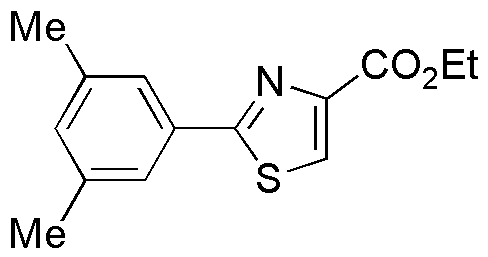2-(3,5-Dimethyl-phenyl)thiazole-4-carboxylic acid ethyl ester is widely utilized in research focused on:
- Agricultural Chemistry: This compound serves as a key ingredient in developing agrochemicals, particularly fungicides and herbicides, enhancing crop protection against pests and diseases.
- Pharmaceutical Research: It is explored for its potential therapeutic properties, particularly in the development of anti-inflammatory and analgesic medications, addressing pain management needs.
- Material Science: The compound is used in synthesizing advanced materials, including polymers and coatings, which offer improved durability and resistance to environmental factors.
- Flavor and Fragrance Industry: It can be utilized in creating aromatic compounds, contributing to the formulation of flavors and fragrances that appeal to consumer preferences.
- Biochemical Applications: Researchers investigate its role in biochemical assays, where it may serve as a reagent or probe, aiding in the study of various biological processes.
General Information
Properties
Safety and Regulations
Applications
2-(3,5-Dimethyl-phenyl)thiazole-4-carboxylic acid ethyl ester is widely utilized in research focused on:
- Agricultural Chemistry: This compound serves as a key ingredient in developing agrochemicals, particularly fungicides and herbicides, enhancing crop protection against pests and diseases.
- Pharmaceutical Research: It is explored for its potential therapeutic properties, particularly in the development of anti-inflammatory and analgesic medications, addressing pain management needs.
- Material Science: The compound is used in synthesizing advanced materials, including polymers and coatings, which offer improved durability and resistance to environmental factors.
- Flavor and Fragrance Industry: It can be utilized in creating aromatic compounds, contributing to the formulation of flavors and fragrances that appeal to consumer preferences.
- Biochemical Applications: Researchers investigate its role in biochemical assays, where it may serve as a reagent or probe, aiding in the study of various biological processes.
Documents
Safety Data Sheets (SDS)
The SDS provides comprehensive safety information on handling, storage, and disposal of the product.
Product Specification (PS)
The PS provides a comprehensive breakdown of the product’s properties, including chemical composition, physical state, purity, and storage requirements. It also details acceptable quality ranges and the product's intended applications.
Certificates of Analysis (COA)
Search for Certificates of Analysis (COA) by entering the products Lot Number. Lot and Batch Numbers can be found on a product’s label following the words ‘Lot’ or ‘Batch’.
*Catalog Number
*Lot Number
Certificates Of Origin (COO)
This COO confirms the country where the product was manufactured, and also details the materials and components used in it and whether it is derived from natural, synthetic, or other specific sources. This certificate may be required for customs, trade, and regulatory compliance.
*Catalog Number
*Lot Number
Safety Data Sheets (SDS)
The SDS provides comprehensive safety information on handling, storage, and disposal of the product.
DownloadProduct Specification (PS)
The PS provides a comprehensive breakdown of the product’s properties, including chemical composition, physical state, purity, and storage requirements. It also details acceptable quality ranges and the product's intended applications.
DownloadCertificates of Analysis (COA)
Search for Certificates of Analysis (COA) by entering the products Lot Number. Lot and Batch Numbers can be found on a product’s label following the words ‘Lot’ or ‘Batch’.
*Catalog Number
*Lot Number
Certificates Of Origin (COO)
This COO confirms the country where the product was manufactured, and also details the materials and components used in it and whether it is derived from natural, synthetic, or other specific sources. This certificate may be required for customs, trade, and regulatory compliance.


